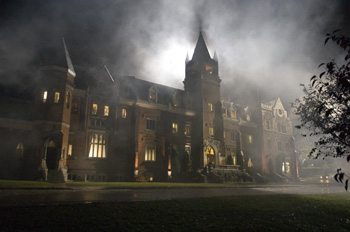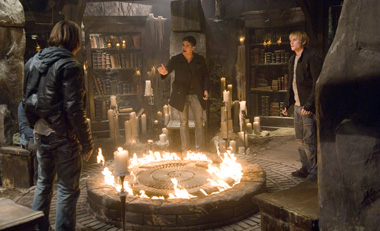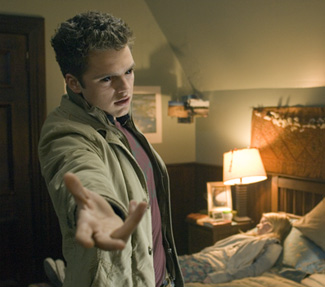 A strikingly handsome young man in a fashionable black coat stands at the edge of a sheer cliff some four stories high. After a ponderous moment, he steps off and begins plunging to what would ordinarily spell death or grievous injury. But rather than be greeted with the expected compound fractures at the bottom, his feet barely disturb the wispy evening mists on the ground, and he then stands and joins his three teenage comrades nearby to survey a beach party below.
A strikingly handsome young man in a fashionable black coat stands at the edge of a sheer cliff some four stories high. After a ponderous moment, he steps off and begins plunging to what would ordinarily spell death or grievous injury. But rather than be greeted with the expected compound fractures at the bottom, his feet barely disturb the wispy evening mists on the ground, and he then stands and joins his three teenage comrades nearby to survey a beach party below.
Our impressively cheekboned protagonist with the controlled descent is actor
We’re in the great gothic Canadian city of
That precipitous rock face is actually a fabricated slab of convincing scenery, surrounded by bluescreen in this massive hangar. Harlin (known on set as “the voice of God” thanks to his resounding voice piped through the ever-present microphone hanging from his neck) jovially demonstrates the complexities of the shot, in which Strait is suspended by a wire rig as the camera rushes up past him, by sacrificing two innocent bottles of water from atop a nearby monitor. But that stunt is a mere hint of the fierce energies that will be displayed during the characters’ clash of perspectives on the use and abuse of such power, in part because it comes with a lethal caveat – after a certain age, this manipulation of energy can become physically draining to the point of death.
We’ll get to see some of that abuse in the finished film – this gigantic former factory also contains a huge barn where the climactic battle occurs. The set’s ceiling is outfitted with a series of complicated high-tech wire tracks (the same equipment used by the Cirque de Soleil) that will propel the actors – doing most of their own stunts – at impressive velocity, using fight choreography that will emulate exaggerated Asian action like the Korean film Volcano High. Taking a break from filming, Harlin and cinematographer Pierre Gill stroll past the Ford Mustang that will later be incorporated in a spectacular sequence, and we sit down in the big replica barn (which it turns out is predominantly Styrofoam for impact cushioning and maximum destructibility) for a chat. Sadly, I forgot to ask about a follow-up to Ford Fairlane…
Q: So an interesting scene takes place in this barn. What happens?
 Renny: Well, it’s a scene with two girls, and they are making out. It’s really interesting. [laughs] It’s a final confrontation between the antagonist and the protagonist. It’s the final action scene which we’ll be shooting here for like nine days. These tracks that you see here in ceiling, they are all flying rigs. Computerized flying rigs. There’s a very complex fight scene which is… It’s not like Matrix, it’s not like Crouching Tiger. It’s something I think people haven’t seen before. These actors are climbing up the walls and flying all over the place.
Renny: Well, it’s a scene with two girls, and they are making out. It’s really interesting. [laughs] It’s a final confrontation between the antagonist and the protagonist. It’s the final action scene which we’ll be shooting here for like nine days. These tracks that you see here in ceiling, they are all flying rigs. Computerized flying rigs. There’s a very complex fight scene which is… It’s not like Matrix, it’s not like Crouching Tiger. It’s something I think people haven’t seen before. These actors are climbing up the walls and flying all over the place.
Q: Is it balletic or more rough and tumble?
Renny: It’s rough, it’s not balletic, it’s not like Crouching Tiger where people are like walking on top of trees and stuff. It’s more fast and rough and dirty. It doesn’t have a kind of like Matrix stuff with people frozen in the air type of stuff. It’s really rough and fast and violent.
Q: Having done two movies in the horror genre before, what have you learned from doing those that you’ve taken into doing this?
Renny: Not to repeat clichés that people have seen before. If you are doing something like that, you have to take the audience in another direction. You have sort of mold them into thinking "Oh, I’m going to see another cliché" and then give them something that actually twists it kind of upside down. That timing is everything. That in a thriller or horror film… it’s like when you are telling a joke, you have to time it perfectly so that you deliver the scare.
It’s very much how you shoot it and how you light it and [
 Renny: It’s also more about the composition than just the darkness. We did this with the bathroom sequence in this big, big bathroom. It’s kind of a scary sequence and we tried to do compositions that are very deliberate. So we are not letting the audience just wander through the movie. We’re telling the audience how to feel about certain situations by putting things in a frame that is very deliberate. Hitchcock did the same thing. So we’re trying to not just shoot whatever happens, but force the audience to follow our perspective.
Renny: It’s also more about the composition than just the darkness. We did this with the bathroom sequence in this big, big bathroom. It’s kind of a scary sequence and we tried to do compositions that are very deliberate. So we are not letting the audience just wander through the movie. We’re telling the audience how to feel about certain situations by putting things in a frame that is very deliberate. Hitchcock did the same thing. So we’re trying to not just shoot whatever happens, but force the audience to follow our perspective.
Q: And what about the actors? Are you using certain camera angles on each one to sort of bring out their character?
Renny: Yes and no. At the beginning of the movie we don’t want to tell who is the good guy, who is the bad guy. It has to be very confusing as much as possible. So we kind of figure out "Oh, is this the new guy? Is this a good guy or no?" We think that this guy in the group is a bad guy. It’s a bit in the acting where they go through that. Like at the beginning, Reid is supposed to maybe be a bad guy but there’s nothing too much on him. There’s not a shot like "whaaa!" and the camera is at a high angle and you’re looking up like a crazy lunatic. So everybody is bit equal so it’s more in the acting, which is more interesting I think.
Pierre: We also use actors and angles that are unusual so that instead of just your normal conversation whereas we try to find angles that do not emphasize who is a good or a bad guy but just to make the audience a little uncomfortable or make them just feel like "Ok, this is not my grandmother’s movie. This is not how it’s always normally done." It would be fast and easy to do just like "Ok let’s do a long lens shot of somebody and follow them." We try to take the time at make it a quality shot.
Q: You must get lots of scripts come to you. What elements of this movie attracted you?
Renny: First of all, this whole world of magic. Which to me, like I sometimes say, this is like Harry Potter for grownups. I like this kind of supernatural world of magic. I think it’s the ultimate wish fulfillment movie that these teenagers can kind of make anything happen. And the visuals that story offers. That kind of imaginary sequences that we can have where you have fun and take the audience into a world on a journey that is not your usual. This just has so much sort of flight of fancy and imagination that for me it’s like the funniest type of a movie to do.
 Q: You work with seasoned vets, and now obviously a young, up-and-coming cast. Do you have any preference on the type of cast you want to work with?
Q: You work with seasoned vets, and now obviously a young, up-and-coming cast. Do you have any preference on the type of cast you want to work with?
Renny: I’m happy to work with both, but for this kind of a movie this is the perfect kind of cast. They are young and eager and inspired and fun to work with. They’ll try anything. They’re always around the set. Always ready to go to work. It would be impossible to make this kind of movie unless we had twice the schedule with the “stars”. It’s just a different process. We’re just all making the same movie together and it’s quite fantastic. All these actors are very talented. Of course you know there are movies where you really want to have somebody major because of their acting talent or you need that… I mean, we all know that if you’re making a big hundred million dollar movie, you’ve got to have somebody that pops out there in the marquee. Unless your movie is called King Kong or
Q: Are you hoping to get a certain rating?
Renny: Definitely PG-13. I’m sure. There’s no blood in the movie. One situation with blood but there’s a lot of action but it’s advocating fun, it’s sort of magical action instead of "Lets smash somebody’s head in."
Q: More action than scary?
Renny: It’s really a mixture, I would say it’s a supernatural action thriller. So it’s definitely scary. It’s very atmospheric and there’s this brooding dark feeling through it all the time. It’s uncomfortable.
Q: Can you give any thoughts on tone, what type of musical elements you want to include in this. Is it going to be instrumental?
Renny: There’s going to be sort of an orchestral, instrumental score. At the moment I have like sixteen places for songs so it’s definitely going to be a lot of cutting edge rock, mainly. There are a lot of situations where driving their car, going to a bar or a beach party, or something like that so there’s a lot of opportunity. Again I reference a little bit like the Lost Boys — it was sort of very hip with music.
Q: The main characters will face some evil force. Over the course of the movie, what makes them better prepared to face that looming threat against them?
 Renny: They are like seventeen in the story, and the idea is that when you’re thirteen you are getting the first taste of your powers. It’s like when you are going through puberty and other kids are worrying about their pimples and something else, they have to worry about the fact that all of a sudden they realize they have these powers. And then they intensify and intensify so I guess, in the course of our story, they grow and learn to be responsible. In the beginning of the story they are kind of happy-go-lucky, like "Ok, lets see who’s got powers", and doing fun stuff and maybe being a little bit reckless. Then when they are faced with this enemy, this person who is going to use these powers for evil purposes, then they kind of realize "Hey, with these powers come responsibility and we have to use them in sort of a way to defeat evil." Something special that we have, that you can see the beauty of it and use it. Not to cure world hunger but still, use it for the positive.
Renny: They are like seventeen in the story, and the idea is that when you’re thirteen you are getting the first taste of your powers. It’s like when you are going through puberty and other kids are worrying about their pimples and something else, they have to worry about the fact that all of a sudden they realize they have these powers. And then they intensify and intensify so I guess, in the course of our story, they grow and learn to be responsible. In the beginning of the story they are kind of happy-go-lucky, like "Ok, lets see who’s got powers", and doing fun stuff and maybe being a little bit reckless. Then when they are faced with this enemy, this person who is going to use these powers for evil purposes, then they kind of realize "Hey, with these powers come responsibility and we have to use them in sort of a way to defeat evil." Something special that we have, that you can see the beauty of it and use it. Not to cure world hunger but still, use it for the positive.
Q: They look pretty powerful, it must be four against one. So their enemy must be really powerful.
Renny: Yes, there are special reasons why the enemy is so powerful, and that the enemy is also young like them.